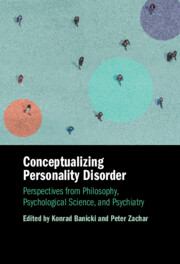 Conceptualizing Personality Disorder
Conceptualizing Personality Disorder Book contents
- Conceptualizing Personality Disorder
- Conceptualizing Personality Disorder
- Copyright page
- Contents
- Figures
- Tables
- Contributors
- Introduction
- Part I Historical Perspectives
- 1 How Personality Disorder Became an Independent Domain in Psychopathology
- 2 Ribot’s Novel Approach to Character Pathology
- 3 What Can the Dimensional Model of Personality Disorders Learn from Mischel’s Classical Challenge to the Trait Theory of Personality?
- Part II Contemporary Approaches to Traditional Conceptual Perspectives
- Part III Novel Conceptual Approaches to Personality Disorder
- Part IV Exploring Negative Consequences of Diagnosing Personality Disorder
- Part V Perspectives on Borderline and Narcissistic Personality
- Index
- References
3 - What Can the Dimensional Model of Personality Disorders Learn from Mischel’s Classical Challenge to the Trait Theory of Personality?
from Part I - Historical Perspectives
Published online by Cambridge University Press: 25 June 2025
- Conceptualizing Personality Disorder
- Conceptualizing Personality Disorder
- Copyright page
- Contents
- Figures
- Tables
- Contributors
- Introduction
- Part I Historical Perspectives
- 1 How Personality Disorder Became an Independent Domain in Psychopathology
- 2 Ribot’s Novel Approach to Character Pathology
- 3 What Can the Dimensional Model of Personality Disorders Learn from Mischel’s Classical Challenge to the Trait Theory of Personality?
- Part II Contemporary Approaches to Traditional Conceptual Perspectives
- Part III Novel Conceptual Approaches to Personality Disorder
- Part IV Exploring Negative Consequences of Diagnosing Personality Disorder
- Part V Perspectives on Borderline and Narcissistic Personality
- Index
- References
Summary
Development of the dimensional models of personality disorders in DSM-5 and ICD-11 is a milestone for trait-theoretic research on personality. For a trait concept, such as “cautious,” “humorous,” to characterize a person’s personality, their behavior must be consistent regarding that concept. Since the 1960s, however, Walter Mischel insisted that human behavior lacks cross-situational consistency, and that it emerges instead from the interplay between personal factors and situational contexts. According to this “interactionism” of personality, it would be difficult to characterize healthy personality in terms of trait concepts. Conversely, the diagnosis of personality disorders requires the existence of maladaptive behavior across diverse situations, which itself is a sign of personality pathology. This chapter discusses some caveats in adopting a dimensional model of personality disorders in the light of Mischel’s arguments, as his perspective is vital when working clinically with individuals with personality disorders. First, one should be cautious about over-diagnosing personality disorders. Second, because personality disorders are characterized by consistent problematic behavior, facet-level rather than domain-level characterization of personality is most clinically relevant from a third-person perspective. Third, personality trait domains do not illuminate the causes of problematic behavior in each individual, which is necessary for treating persons with personality disorders.
Keywords
Information
- Type
- Chapter
- Information
- Conceptualizing Personality DisorderPerspectives from Philosophy, Psychological Science, and Psychiatry, pp. 40 - 56Publisher: Cambridge University PressPrint publication year: 2025